
Frank Heyling Furness was an American architect of the Victorian era. He designed more than 600 buildings, most in the Philadelphia area, and is remembered for his diverse, muscular, often inordinately scaled buildings, and for his influence on the Chicago-based architect Louis Sullivan. Furness also received a Medal of Honor for bravery during the Civil War.

Horace Howard Furness was an American Shakespearean scholar of the 19th century.

Rittenhouse Square is a neighborhood, including a public park, in Center City Philadelphia, Pennsylvania. Rittenhouse Square often specifically refers to the park, while the neighborhood as a whole is referred to simply as Rittenhouse. The park is one of the five original open-space parks planned by William Penn and his surveyor Thomas Holme during the late 17th century.
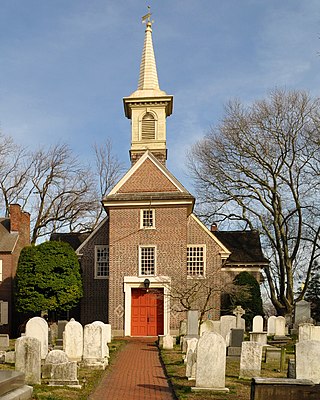
The architecture of Philadelphia is a mix of historic and modern styles that reflect the city's history. The first European settlements appeared within the present day borders of Philadelphia, Pennsylvania in the 17th century with most structures being built from logs. By the 18th century, brick structures had become common. Georgian and later Federal style buildings dominated much of the cityscape. In the first half of the 19th century, Greek revival appeared and flourished with architects such as William Strickland, John Haviland, and Thomas U. Walter. In the second half of the 19th century, Victorian architecture became popular with the city's most notable Victorian architect being Frank Furness.

Philadelphia's Baltimore and Ohio Railroad station – also known as the B & O station or Chestnut Street station – was the main passenger station for the Baltimore and Ohio Railroad in Philadelphia, Pennsylvania. Designed by architect Frank Furness in 1886, it stood at 24th Street and the Chestnut Street Bridge from 1888 to 1963.

Wilson Eyre Jr. was an American architect, teacher and writer who practiced in the Philadelphia area. He is known for his deliberately informal and welcoming country houses, and for being an innovator in the Shingle Style.

Edward Townsend "Ned" Stotesbury was a prominent investment banker, a partner in Philadelphia's Drexel & Co. and its New York affiliate J. P. Morgan & Co. for over fifty-five years. He was involved in the financing of many railroads. Stotesbury, West Virginia, a coal mining town in Raleigh County, is named for him, as well as his equestrian estate, the Stotesbury Club House. Several of the palatial estates he built with his second wife have been demolished in the years since his death.
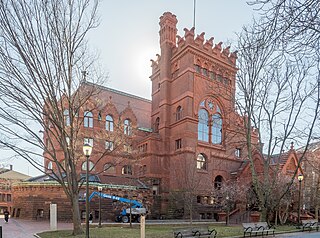
The Fisher Fine Arts Library was the primary library of the University of Pennsylvania in Philadelphia from 1891 to 1962. The red sandstone, brick-and-terra-cotta Venetian Gothic giant, part fortress and part cathedral, was designed by Philadelphia architect Frank Furness (1839–1912).

The Centennial National Bank is a historic building in Philadelphia, Pennsylvania. Designed by noted Philadelphia architect Frank Furness and significant in his artistic development, it was built in 1876 as the headquarters of the eponymous bank that would be the fiscal agent of the Centennial Exposition. The building housed a branch of the First Pennsylvania Bank from 1956 until Drexel University purchased it c. 1976. Drexel renovated it between 2000-2002 and now uses it as an alumni center. The Centennial National Bank, described as "one of the best pieces of architecture in West Philadelphia," was placed on the National Register of Historic Places in 1971.

Daniel Pabst was a German-born American cabinetmaker of the Victorian Era. He is credited with some of the most extraordinary custom interiors and hand-crafted furniture in the United States. Sometimes working in collaboration with architect Frank Furness (1839–1912), he made pieces in the Renaissance Revival, Neo-Grec, Modern Gothic, and Colonial Revival styles. Examples of his work are in the collections of the Metropolitan Museum of Art, the Philadelphia Museum of Art, the Art Institute of Chicago, and the Victoria and Albert Museum in London.

Solomon House is an 1887 brick-and-brownstone building at 17th and Moravian Streets in Center City Philadelphia, Pennsylvania. It was designed by the architectural firm of Furness & Evans, headed by Frank Furness, Philadelphia's leading architect in the last quarter of the 19th century. It was built as the southernmost of a row of five city houses by developer Joseph Solomon and contractor B. Ketcham. It became Solomon's own house, and is the only one of the five still standing.

Dolobran is a Shingle Style house at 231 Laurel Lane in Haverford, Pennsylvania. It was designed by architect Frank Furness for shipping magnate Clement Griscom in 1881, and was expanded at least twice by Furness. The house and 146-acre estate served as a summer retreat for Griscom, his wife, and five children.
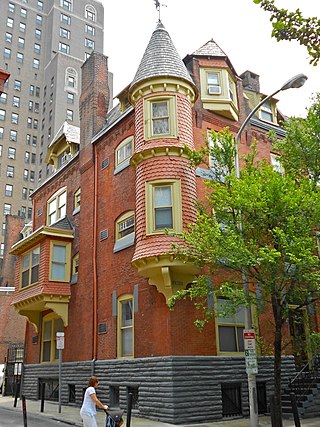
Hockley Row, also known as Evans Row or Victoria House, is a set of four architecturally significant rowhouses, which are located in the Rittenhouse Square West neighborhood of Philadelphia, Pennsylvania.

Furness & Evans was a Philadelphia-based architectural partnership, established in 1881, between architect Frank Furness and his former chief draftsman, Allen Evans. In 1886, other employees were made partners, and the firm became Furness, Evans & Company. George Howe worked in the firm and later became a partner at Mellor & Meigs, another Philadelphia firm.
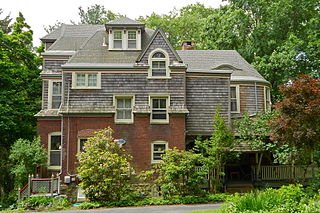
Idlewild is a historic building near Media, Pennsylvania, designed by the Victorian-era Philadelphia architect Frank Furness as a summer cottage for his family. He spent summers there until his death in 1912.

Edward Maene was a Belgian-American architectural sculptor, woodcarver and cabinetmaker.

Allen Evans was an American architect and partner in the Philadelphia firm of Furness & Evans. His best known work may be the Merion Cricket Club.

Lindenshade, Wallingford, Pennsylvania, was the Wallingford country house and farm of Shakespearean scholar Horace Howard Furness (1833–1912) and family. The house's design is attributed to his brother, architect Frank Furness. It was expanded numerous times, and demolished in 1940. Two other buildings from the property survive. The Helen Kate Furness Library, a memorial to HHF's wife, was built at the west end of the property in 1916.
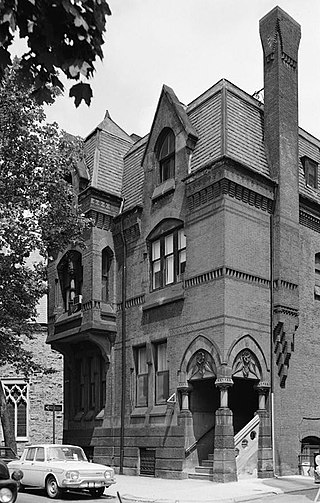
The Thomas Hockley House (1875) is a Victorian city house in Philadelphia, Pennsylvania, designed by architect Frank Furness. Located west of Rittenhouse Square, it is a contributing property in the Walnut–Chancellor Historic District.

Walter Rogers Furness Cottage (1890-1891) – also known as the "Old Infirmary" or the "Jekyll Island Infirmary" – is a Shingle Style building on Jekyll Island, in Glynn County, Georgia, United States.



























